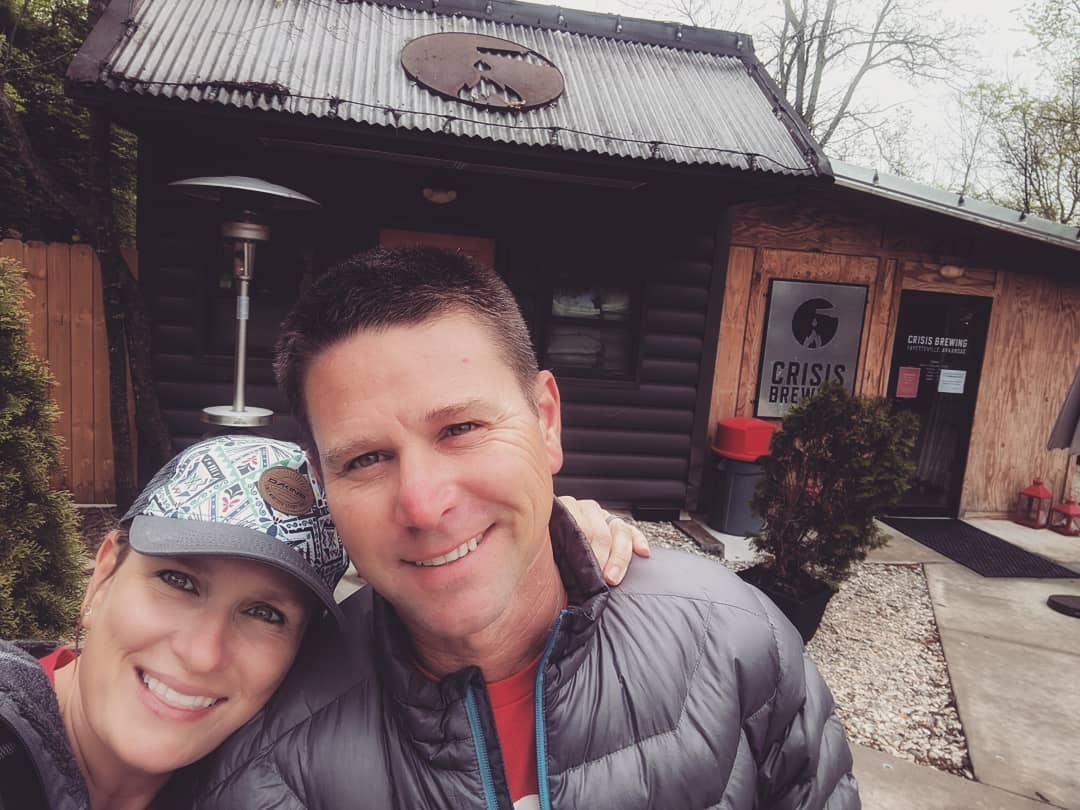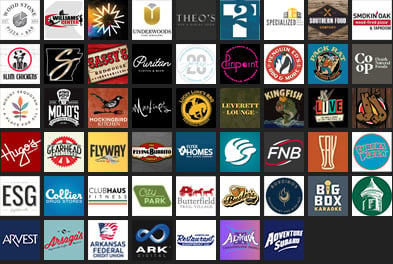
Crisis Brewing Co. owners Liz and Sean Slape / Courtesy photo
These are strange times we’re living through. Fayetteville seems like a ghost town at times.
For Crisis Brewing Co., the coronavirus casts a long shadow on what has been a very successful first two years in business.
“It’s been strange, there’s no doubt about it,” says Crisis co-owner and brewmaster Sean Slape. “Moving around town you don’t see very many people.”
Slape’s taproom was a busy place just a few weeks ago. People jammed in for pints of Identity IPA and O-Face Cream Ale, and it was all he could do to meet demand with the tiny two-barrel brewhouse behind the bar.
Now the place is mostly empty, with the exception of brewery staff and customers picking up to-go orders.
“It went by incredibly fast,” said Slape, referring to his first two years of commercial brewing. “The neighborhood supported us like crazy, and we were doing everything we could do to keep up.”
If we were still living in normal times there would be a big birthday celebration at the brewery this month. Instead, Crisis — like other breweries across Arkansas — has adjusted to a new operating reality.
Being small, those adjustments might be a bit easier to make at Crisis. When he operates at peak efficiency, Slape can produce up to 165 barrels per year, with nearly every drop sold in the taproom.
That number pales in comparison to others in Arkansas. Lost Forty Brewing Co. — the state’s largest — produced 14,250 barrels in 2018 (the last year for which official statistics are available). Here in Northwest Arkansas, Core Brewing Co. and Ozark Brewing Co. made 4,800 and 4,077 barrels respectively in that same year.
“It was designed like that on purpose,” Slape said, referring to the brewery’s miniscule size. “I wanted to keep the beer rotating and always fresh.”
Operating on a small scale also means he can avoid the pain of lost draft volume at shuttered bars and restaurants. Bigger breweries are more dependent on those off-premise accounts, and thus have been more negatively impacted by COVID-19.
I recently talked to Slape on the brewery’s back patio. In keeping with current health recommendations, we sat more than six feet apart while discussing the impact of the coronavirus disease on his business, the new production facility he’s building in Fayetteville, and his love for homebrewing.
And since many people are looking for things to do while stuck at home, he offered a homebrew recipe for one of Crisis’ most popular beers.
How has the virus impacted the brewery?
I don’t know how to say it other than it’s pretty bizarre. From a brewery perspective, we lost our taproom business because we had to close it down. What we’ve seen over the last month is that our to-go sales have really kept this place afloat. The crowler [32-ounce can] machine has really helped us out. Before everything got crazy I was talking to Jesse Gagnon at West Mountain and Casey Letellier from Ivory Bill about them. It seemed like a great idea, but there’s almost no place to put one in here. Now, with nobody in the taproom, we can put it right up on the bar.
When the slowdown started I thought I would have some down-time, but with the increase in to-go sales, I’ve kept my brewing schedule pretty much the same. I can’t say enough about the local beer community, which has been so incredibly supportive. I almost feel guilty sometimes because we’re very lucky. Yet, it has been hard not having people in here to talk to, to have friends sit down to enjoy themselves and have a beer. We sure do miss having the taproom open.
What’s on the horizon for Crisis Brewing Co.?
We’re building out a production facility in the industrial park, south of town. I’m dividing my time between here and there, and I’m hoping that by the time everything starts to ease up with the virus, beer will be coming out of the new facility. It’s a seven-barrel system from Stout Tanks and Kettles in Portland, Oregon. There are three tanks in the brewhouse — a hot liquor tank, mash tun, and kettle — and it’s all-electric. We’re putting quite a bit of automation on it. We’ll have four seven-barrel fermenters down there, and the rest will be small three- or four-barrel fermenters so we can do small batches and constantly turn new beers.
It’s exciting and scary because the whole idea of putting a facility like that together is to distribute to restaurants around here. We’re fortunate in the sense that we aren’t ready to produce beer yet so we can wait the virus situation out. The original taproom is tiny and it’s easy to keep it going. If we need to put the production facility on hold we can.
You started out as a homebrewer. What did the hobby mean to you back then?
It was all about doing something creative with friends. When I first started homebrewing there weren’t as many good beers available, so you had to make your own. The first time I ever brewed was with a Mr. Beer kit around 2004. Those beers were awful, plain and simple. And then I probably started messing around with all-grain around 2005 or 2006. It sounds like a long time ago, but to me it seems like yesterday. I enjoyed tweaking my beer to make it the best it could be. My friends would tell me how great my beer was, even back when it was terrible. It was a lot of fun to hang out with friends, brew some beer, and relax.
Crisis is just a glorified homebrew setup. Since we’re small, I’m not the kind of brewer that can buy ingredients on contract. I buy in small amounts, and since ingredients like malt and hops can vary in flavor [between lots], I might change the recipe a little bit each time to compensate. I try not to worry too much as long as the beer is high-quality. My background as a homebrewer really helps with that approach.
Homebrew recipe for Fayzed Hazy India Pale Ale

According to Slape, this is the original recipe for Fayzed. It has transformed over time, but should give homebrewers a good place to start when brewing a hazy IPA.
Batch size: 10 gallons
Brewhouse efficiency: 75%
Original gravity: 1.063
Final gravity: 1.015
ABV: 6.4%
IBUs: 47
Malt/grain bill
20 lbs Pale Malt (87%)
2 lbs Vienna (8.7%)
1 lb Caramunich (4.3%)
Hops & additions schedule
0.25 oz Apollo (18.2% Alpha Acid) Boil 60 minutes
0.50 oz Citra (12.5% AA) Boil 20 minutes
1.00 oz Citra (12.5% AA) Boil 5 minutes
4.00 oz Citra (12.5% AA) Whirlpool 10 minutes
4.00 oz Citra (12.5% AA) Whirlpool 0 minutes
5.00 oz Citra (12.5% AA) Dry hop 3 days
Yeast
White Labs WLP-001 California Ale Yeast
Instructions
Mash the grains at 152°F for 60 minutes. Sparge with 168°F water to achieve a boil volume of 12.5 gallons. Boil wort for 90 minutes, adding hops at times indicated above. Once the boil is complete, begin a whirlpool and let rest for at least 30 minutes. Chill the wort to 68°F, transfer to a fermenter, and pitch the yeast. After one week of fermentation, transfer to secondary fermenter and condition for 10 days at 55°F. Add dry hops and condition for another 4 days at 55°F. Package, carbonate, and enjoy.
Extract Substitution
To brew with malt extract rather than grain, substitute the malt listed above with 18 lbs, 7 oz pale liquid extract and 1 lb CaraMunich 60.
Steep the Caramunich in 12.5 gallons of water at 155°F for 30 minutes. Remove the grain and bring to a boil. Add the extract and begin the 90-minute boil, adding hops as indicated in the recipe. The rest of the process will be the same.

